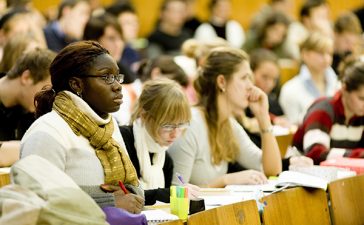With the exception of a few luminaries such as former Harvard University president Drew Gilpin Faust and feminist professor Judith Butler at the University of California, Berkeley, from astrophysicist Neil deGrasse Tyson (Princeton) to the linguistics professor and social commentator Noam Chomsky (MIT), the public face of American colleges and universities is predominantly male.
But the hyper-masculine world of National Collegiate Athletic Association’s conferences – the Big Ten, Pac-12 or Southeastern Conference – and their legions of college football and basketball fans differ markedly from who is actually on the campuses. On the quadrangles of the nation, women outnumber men by 60% to 40%.
“There is a gender gap in education generally, but that gap is magnified and illuminated once we hit the university level,” says Dr Richard V Reeves of the New York-based Brookings Institution.
“We see it in the transition from high school to university, and we see it in the ability to stay at university. The gender inequality that we see with regard to college is not just with enrolment but in completion. The US has a real problem with completion by comparison to enrolment. But getting onto campus is not the same thing as leaving the campus with a credential.”
Gender gap reversed
Since 1970, the number of students enrolled in America’s colleges and universities has more than doubled, to 16,686,893. Over this period, the male-female ratio has changed by 26%. In 1972, the year (Federal) Title IX laws designed to promote gender equity came into force, there were 12% more males on campus than females. Over the next decade the gap vanished. By 2019, a 14-percentage point gap had opened, this time with there being more women than men.
This change is manifest in almost every department and faculty. In 2018-19, according to the National Center for Education Statistics, in psychology, for example, women earned more than three and a half times the number of degrees men did: 92,223 to 24,313. In the same year, 32,704 men earned diplomas in communications while almost 60,000 women did.
Before Title IX was passed, 11% of the veterinary students were female; by 2007, 75% were.
According to a Pew Research Center report published last April, in STEM (science, technology, engineering and mathematics), women earn 35% of mathematics masters degrees, 37% of physical sciences, 27% of engineering and only 19% of computer science degrees. However, women earned 58% of life science (agriculture, environmental science and biology) degrees and 83% of degrees in health-related fields.
In 2019, the Association of American Medical Colleges reported that women made up 52.4% of matriculants.
We know that education is good for the economy and for society, says Reeves. More educated people tend to be healthier and there is a well-established link between education and economic growth.
“That’s one of the reasons why, even today, we work so hard to get more women into education. The cause of women’s education has always been one of gender equity, of course, but it’s also been one of economic development, and that is just as true today, just as true of men.”
Pandemic impact
The COVID-caused drop of 603,000 in last year’s enrolment did not affect men and women equally. The percentage drop for men was seven times larger than for women: -5.1% to -0.7%.
According to the National Student Clearinghouse, over the past five years, as the university-aged cohort has declined nationwide, university enrolment has declined by 1.5 million; 1.1 million or 71% of these vacant chairs would have been filled by men.
Writing in a report titled The male college crisis is not just in enrollment, but completion, published by the Brookings Institution earlier this month, Reeves and Ember Smith have sounded the alarm about the length of time it takes men, as compared to their female peers, to either attain an associate bachelor degree (from a two-year college) or a bachelor degree from a four-year college or university.
(Two-year community colleges provide both technical education and college-level courses, thus providing a pathway to four-year colleges and universities for academically weaker students as well as for underprivileged students, a disproportionate percentage of whom are black or Latinx.)
In addition to men making up more than half of the 40% of undergraduates who drop out from college, many of those who remain follow what Reeves calls a “zig zag” path that contrasts starkly with the “smoother path we see women taking” through higher education.
According to Reeves and Smith, only 40% of men graduate from college or university in four years as against 50% of women. In five years, a total of 55% of men will have graduated while the figure for women is close to 65%. After six years (that is, 150% of the ‘normal time’ needed to earn a four-year degree), a total of 60% of men and 67% of women will have a diploma.
The problem with this ‘stop-start’ trajectory is not just that men take longer to graduate (and in many cases end up paying more for their degree because they were enrolled over more semesters).
“It has consequences,” Reeves says, “because it means that men are easier to derail.”
The dating gap
In an interview on CNN in late September, after host Michael Smerconish introduced viewers to the 20-percentage point differential between the number of women and men on campus, Scott Galloway, professor of marketing at New York University’s Stern School of Business, said that this gap in education negatively impacts the formation of couples.
While the number of men and women on the dating app Tinder is equal, Galloway continued, women are interested in only 4% of the men. “What do those for women have? They signal success with a college degree. Women aren’t interested in mating with men who don’t have college degrees.”
(Galloway’s point belongs to what psychologists call ‘assortative mating’, whereby couple-formation decisions are based on such observable characteristics as religion or, in this case, education. Though important on its own, education also acts as a stand-in for interests, ability to commit to and carry through with a long-term project and future prospects.)
According to Galloway, the mismatch between the number of college-educated men and women risks destabilising American society.
“You are going to have,” he told Smerconish, “the most dangerous person in the world: a broke and lonely male.
“If you look at the most unstable, violent societies in the world, they all have one thing in common. They have young, depressed men who aren’t attached to work, aren’t attaching to school and aren’t attaching to relationship.”
Galloway then warned that the “mating inequality that’s going to come out of this dearth of men in college poses an existential risk to our economy and our society”.
Reeves eschews the apocalyptic rhetoric and notes that while the female-male discrepancy on campus had been growing for almost two decades, marriage rates among college-educated men and women have remained relatively stable.
He is, however, concerned about the long-term impact that the education gap and the “delayed adulthood” of many men has on both family structure and the economy. Delayed college graduation means, he told University World News, that these men are getting into the labour market later and, thus, become economically independent later than the women in their age cohort. This, then, delays both family formation and buying the first home.
When I asked Reeves about the fact that in most academic disciplines, women outnumber men at the postgraduate level, he answered: “Let me be really blunt about it. The problem is not that more women are getting masters degrees while their husbands are only getting bachelor’s degrees. The problem is we have a lot of men who are not getting any kind of qualification or very little.
“This is especially true of men who come from poor backgrounds and men of colour. There’s a real class gap here. Men who come from poor backgrounds are badly served by the education system, and, honestly, they’re nowhere near a bachelor’s degree.”
No surprise
A 2006 study published in the Journal of Economic Perspectives by Harvard University professors Claudia Goldin and Lawrence F Katz and their researcher Ilyana Kuziemko showed that the reversal of the college gender gap should not have come as a surprise.
The gap had nothing to do with women’s academic abilities, as was clear during the first three decades of the 20th century when the numbers of men and women attending institutions of higher education were roughly equal.
Rather, the gap was a post-Second World War phenomenon, the result of the GI Bill, which saw 2.2 million men go to college and university in the late 1940s, which pushed the number of Americans in higher education from 1.1 million before the war to 2.4 million in 1949.
In 1947, my mother was one of two female sophomores in Brooklyn College’s faculty of music, so it came as no surprise to read that that year there were 2.3 men for every one woman on America’s campuses.
In 1957, IQ tests in Wisconsin, Goldin et al noted, revealed an “almost identical distribution by sex”. In 1972, high school tests in Wisconsin showed the well-established pattern of girls being ahead in reading while boys were ahead in maths; two decades later, after educators had reworked the maths curriculum to remove gender bias, the maths gap narrowed, while girls pulled further ahead in reading. By 1992, girls had achieved parity in maths and maintained their lead in language arts.
Further, Goldin et al underlined, “one source of persistent K-12 performance and the new female lead in college attainment is the higher incidence of behavioural problems (or lower level of non-cognitive skills) among boys.”
These ‘non-cognitive skills’, what psychologists call ‘executive functions’, Reeves explained, are central to understanding why young men struggle in college and university, and why Reeves thinks that both the K-12 and even post-secondary levels are biased in favour of girls and women.
At every level of K-12 education, girls and young women are one to two years ahead of boys and young men, with the gap being the widest in adolescence, precisely the age when they enter college or university.
(It should be noted that the millions of men who attended and graduated in record numbers from college and university on the GI Bill intake were not just older than the average undergraduate by six or seven years but, as former soldiers, they would have had much more developed non-cognitive organisational skills.)
“Executive functioning skills allow you to turn in your homework on time and keep on top of your work. They allow you to stay in and study rather than going out and party,” says Reeves. “There’s a maturity gap on those skills in favour of girls and young women at just the point in the education system where they really count for a great deal.”
Demotivating for boys
Lakeland Community College, not far from Cleveland, Ohio, is perhaps the only institution of higher learning in the United States with a Men’s Resource Centre (modelled on the centres designed to help female students that are found in almost every college or university in the country).
Jim Shelley, who has directed it for 25 years, has worked with thousands of both prospective male students who need support and matriculating ones who are at risk of dropping out. He thinks that for many the “failure to launch” into a successful college career has roots stretching back to elementary school and, especially, to their experiences learning to read and write.
On average, he told me, “boys are a year behind girls in terms of literacy when they begin school. And this continues in place through high school and into college.” This gap affects more than report card grades. It affects boys’ fluency with literacy.
“Boys want to be good at what they do or they don’t want to do it. And, if you start school and you’re in effect a benchwarmer on the literacy team, you’re never going to be the best in that category. You are going to lose interest. You’ll still have to do it, and so boys do it [read and learn to write] reluctantly,” Shelley says.
As did Reeves, Shelley decries the fact that there is no state or federal government programme (or even much consciousness of the problem boys and the male students who come to him have with reading and writing) that is comparable to the programmes designed to enable girls to achieve equity in math.
He added, with a note of envy, that the British government is taking steps to address the literacy gap. (For its part, through the Scottish Funding Council, the Scottish government has set a target to reduce the gender gap in Scottish universities by five percentage points by 2030; every university is required to submit a plan to achieve this goal.)
Shelley and his staff help students with a myriad of problems, including financial, legal, family problems as well as homelessness. For students who cannot organise themselves, that is, students who display weaker ‘executive function’ skills vis-à-vis college, Shelley or his staff help them to develop study plans.
With almost every student, Shelley risks touching a raw nerve, telling them that “to advance in any career and here at Lakeland if they want to take advanced courses, they have to develop written skills”.
Those students in need are directed toward other programmes at the college designed to help students who are struggling with reading and writing. Lakeland has articulation agreements with a number of universities that students can transfer to and receive full credit for courses taken at the community college, so improvement in these areas opens the door to a student being able to realistically think about going on to a four-year university to get a bachelor degree.
Among the changes Shelley would welcome would be a return to the quarterly system, under which there were four quarters, fall, winter, spring and summer (though most students did not attend the summer quarter). Under the semester system now in place (and used by most American colleges and universities), there are two main semesters, fall and winter, each of 15 weeks.
Male students, especially at-risk ones, Shelley told University World News, do not seem to do as well in the semestered system because it is longer. They don’t do as well with delayed gratification (ie getting a final grade).
“I’ve had students who have started my classes in January and they’d be gone by March.” Under the quarterly system, they would be getting a grade in March.
The very fact that the Men’s Resource Centre (MRC) has been operating for 25 years indicates that the college’s administration sees it as providing a net benefit to male students who are battling and might otherwise drop out.
Determining how many of these at-risk students Shelley and his team have kept in school is, he told me, rather difficult.
Instead, he pointed to a study comparing students who were recipients of Pell Grants (a federal programme that helps support students from lower economic backgrounds) who sought out help at the MRC with those Pell Grant recipients who did not seek out help.
Those students that came through the MRC’s doors had a grade point average one quarter point higher and a credit completion rate (courses completed vs attempted) 8.3% higher.
Cause for celebration
The news that after hovering near the 60:40 split, the reality on America’s campuses today is that there are six women for every four men, did not surprise Doug Shapiro, executive director of the National Student Clearinghouse Research Center. The large number of women in and completing higher education is, he told University World News, something to be celebrated.
“This is a huge success story for women in terms of their long-term historic transition into the labour force.”
It didn’t take long, however, for Shapiro to note that implications of the ongoing gender disparity across the entire field of American institutions of higher education – including private four-year colleges where the gap is 65%, 2,271,247 to 1,476,674 – is not an unalloyed good.
Even though in comparison to the past, there are more men graduating from college and university, the trend line has unsettling workforce implications.
“Most of the new jobs that have been created since the Great Recession (2008-09) require some form of post-secondary education,” he says. The trend “raises questions about who will have access to these well-paying jobs in the future”.
“If you are looking at a larger group, a larger percentage of females who will be able to enter the knowledge economy, to use that hackneyed term, that has obvious implications for society and for men’s employment.”
For his part, Reeves summed up the pecuniary and educational or social policy arguments by saying: “The economic return for college education is pretty similar for men and women. So, if you see a group that is lagging behind, then you should worry.”







